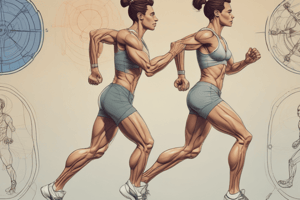Podcast
Questions and Answers
What is the primary purpose of muscle-strengthening activities?
What is the primary purpose of muscle-strengthening activities?
- To improve endurance and respiratory capacity
- To promote relaxation and reduce stress
- To make muscles work against an applied force (correct)
- To enhance flexibility and balance
Which of the following activities is considered muscle-strengthening activity?
Which of the following activities is considered muscle-strengthening activity?
- Lifting weights (correct)
- Cycling on a flat surface
- Swimming continuously
- Jogging at a steady pace
Which type of activity is specifically aimed at promoting bone growth through applied force?
Which type of activity is specifically aimed at promoting bone growth through applied force?
- Aerobic exercises
- Flexibility routines
- Muscle-strengthening activities
- Bone-strengthening activities (correct)
What is a common barrier that prevents individuals from engaging in physical activities?
What is a common barrier that prevents individuals from engaging in physical activities?
What might discourage someone from muscle-strengthening activities specifically?
What might discourage someone from muscle-strengthening activities specifically?
What does muscular strength refer to?
What does muscular strength refer to?
Which of the following is NOT a component of muscular strength?
Which of the following is NOT a component of muscular strength?
How is muscular strength primarily developed?
How is muscular strength primarily developed?
What is a common misconception about muscular strength training?
What is a common misconception about muscular strength training?
Which activity most effectively showcases muscular strength?
Which activity most effectively showcases muscular strength?
What role does muscular strength play in overall physical fitness?
What role does muscular strength play in overall physical fitness?
Which of the following is a benefit of muscular strength training?
Which of the following is a benefit of muscular strength training?
In a fitness assessment, what would most likely indicate a high level of muscular strength?
In a fitness assessment, what would most likely indicate a high level of muscular strength?
What defines muscle strength?
What defines muscle strength?
Which of the following best describes power in physical fitness?
Which of the following best describes power in physical fitness?
How is endurance characterized in physical fitness?
How is endurance characterized in physical fitness?
Which option accurately represents a component of physical fitness related to respiratory and circulatory health?
Which option accurately represents a component of physical fitness related to respiratory and circulatory health?
What is the role of flexibility in physical activity?
What is the role of flexibility in physical activity?
Which of the following best describes speed in the context of physical activity?
Which of the following best describes speed in the context of physical activity?
What are the domains of physical activity focused on?
What are the domains of physical activity focused on?
Which statement about exercise is accurate?
Which statement about exercise is accurate?
Flashcards are hidden until you start studying
Study Notes
Physical Fitness Components
- Balance: Control of organic equipment, representing a state of equilibrium.
- Coordination: Integration of body parts for smooth motion.
- Endurance: Sustaining long contractions with multiple muscle groups, resisting fatigue over time.
- Flexibility: Ability to perform a wide range of movements, indicating plasticity.
- Organic Vigor: Soundness of heart and lungs, crucial for disease resistance.
- Power: Release of maximum muscular force in minimal time.
- Speed: Quick successive movements of the same kind in the shortest time.
- Strength: Sustaining force application against resistance without yielding.
Domains of Physical Activity
- Occupational: Activities performed at the workplace, such as lifting and moving.
- Domestic: Home activities like cleaning and cooking.
- Transportation: Travel-related activities including biking and public transit.
- Leisure Time: Recreational activities such as sports and hobbies.
Definition of Exercise
- Planned, structured, repetitive bodily movements aimed at improving or maintaining physical fitness or health.
Health and Body Fitness
- A physically fit person can engage in sports and activities while retaining energy.
- Health Fitness: Body's ability to resist diseases.
- Body Fitness: Capability to perform strenuous activities without fatigue.
Health-Related Fitness Components
- Body Composition: Combination of tissues in the body, including fat, muscles, and organs.
- Cardiovascular Endurance: Efficiency of the heart, lungs, and blood vessels in supplying oxygen.
- Flexibility: Full range of motion of the joints.
- Muscular Endurance: Muscle use over extended periods without fatigue.
- Muscular Strength: Ability to lift heavy weights or exert high force.
Skills-Related Fitness Components
- Agility: Quick change of body position while maintaining control.
- Balance: Steady body positioning during movement.
- Coordination: Synchronized body parts during activities.
- Power: Combination of strength and speed in movement.
- Reaction Time: Quick movement in response to a signal.
- Speed: Rapid movement of all or part of the body.
Specific Physical Activities
- Agility: Ability to swiftly change direction while maintaining balance.
- Aerobic Activities: Endurance exercises that utilize large muscles in rhythmic motion.
- Muscle-Strengthening Activities: Resistance training to work against applied force.
- Bone-Strengthening Activities: Weight-bearing exercises promoting bone density and strength.
Barriers to Physical Activities
- Lack of time.
- Insufficient social support.
- Low energy levels.
- Lack of motivation.
- Fear of injury.
- Inadequate skills.
- High costs and lack of facilities.
- Weather conditions limiting outdoor activities.
Studying That Suits You
Use AI to generate personalized quizzes and flashcards to suit your learning preferences.




